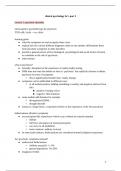College aantekeningen
aantekeningen HC's part 2 clinical psychology
college aantekeningen tweede deel van het vak gekoppeld aan boek; Kring & Johnson (2022), Abnormal Psychology, The Science and Treatment of Psychological Disorders (15th Edition
[Meer zien]




